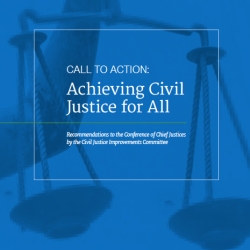Judges Shift to Videoconferencing to Keep Justice System Moving Amid Coronavirus
Courts across the country continue to exhibit incredible flexibility in the wake of the COVID-19 pandemic. Now that shelter-in-place and stay-at-home orders have been enacted in many parts of the country, judges and lawyers alike are looking for ways to keep court cases and processes moving. While courts are essential to the civil justice system, physical gatherings at courthouses are currently not in the best interest of public health and safety. Last week, for the first time in its history, the North Dakota Supreme Court heard oral arguments via videoconferencing. North Dakota is one of many states to cut back or suspend jury trials entirely, as well as move much of the court's business to digital platforms. Connecticut, Delaware, and New Mexico courts all issued statewide temporary mandates requiring videoconferencing.
Holding arguments during a pandemic. https://t.co/htobKbQLfb pic.twitter.com/VnwRqgACDR
— Jerod Tufte (@JudgeTufte) March 24, 2020
On March 13, 2020, the Alaska Supreme Court issued an extensive order that includes the relaxation of court rules for telephone and videoconferencing to “liberally allow participation by attorneys, parties, and witnesses by telephone or videoconference if feasible based on the circumstances. In a civil proceeding, a judge may allow a party to appear through the party’s attorney.” Oral arguments before the Supreme Court of Alaska in March and April are now argued by telephone, and the public may attend by video feed on the Gavel Alaska website. The Alaska Courts homepage now says “Feel sick? Call, don’t come!”
Texas has wholeheartedly embraced videoconferencing technology during this uncertain time. On March 13, the Supreme Court of Texas issued the first of now eight Emergency Orders, allowing remote participation in any civil or criminal proceeding by teleconferencing, videoconferencing, or other means. In order to keep cases moving, the Texas Office of Court Administration has set up more than 400 Texas judges with Zoom accounts and hosted a training webinar just last week with 500 participants. The Texas Judiciary website has an Electronic Hearings webpage devoted to videoconference initial set-up, training, frequently asked questions, and tips for successful hearings for judges.
Of course, this sudden pivot has also led to challenges. People are also struggling to learn new technology on the fly, with faulty internet connections and noisy backgrounds. And while privacy issues are now surfacing for popular videoconferencing providers, there are ways to make sure connections are as secure as possible.
Courts’ use of digital conferencing is not a new concept; it is a vital component of the 13 recommendations for improving the American civil justice system, endorsed in 2016 by the Conference of Chief Justices (CCJ) and the Conference of State Court Administrators (COSCA). Recommendation 13 calls on courts and judges to use technology to provide superior access for litigants. Specifically:
“Judges should promote the use of remote audio and video services for case hearings and case management meetings.”
The Civil Justice Initiative Committee issued additional findings and recommendations on remote conferencing for courts in Appendix G, recognizing that “videoconferencing can reduce cost and delay,” and can “positively affect access to justice for litigants, especially self-represented litigants.”
Despite challenges, courts have shown a remarkable ability to adapt to a much more remote and technology-driven version of our justice system.



